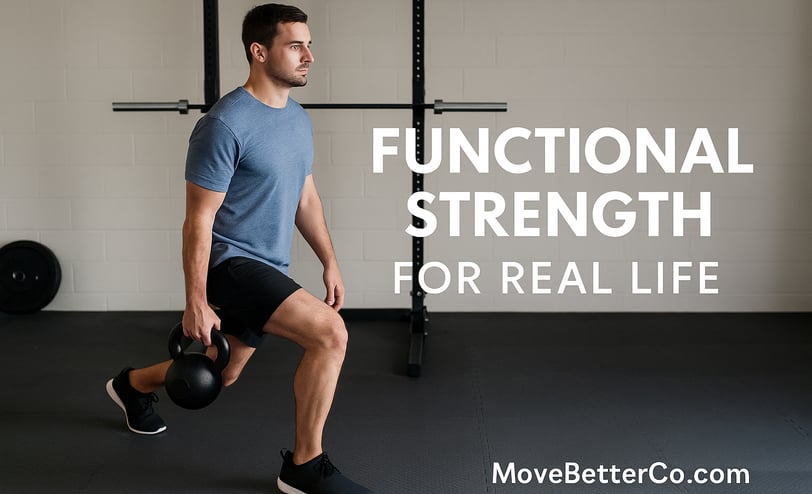Building Real-World Strength: Functional Training for Everyday Life
Learn how to build functional strength that actually carries over into real life. This guide breaks down movement patterns, core training, balance work, and must-have gear to help you move better, feel stronger, and prevent injuries.
6/1/20252 min read


Building Functional Strength for Everyday Activities
It’s one thing to be strong in the gym — it’s another to be strong where it actually counts. Functional strength is all about preparing your body for real-life movements: lifting groceries, carrying your kid, climbing stairs, or even just keeping good posture at your desk. Instead of isolating one muscle at a time, functional training trains your body to move better as a whole unit.
Why Functional Strength Matters
Most of us don’t need to deadlift 500 lbs. What we really need is to avoid throwing out our backs when we twist the wrong way, or feeling pain from sitting all day. Functional training develops strength that transfers to daily life — improving balance, coordination, and joint stability. It’s especially key for injury prevention, aging well, and handling unexpected movements (like catching yourself during a fall or pivoting quickly).
Studies from the Journal of Strength and Conditioning Research show that functional training can improve strength, mobility, and performance in both athletes and older adults — and reduce injury risk across the board.
Start with Movement Patterns
Before you even pick up a weight, it’s about learning how to move. Think squatting, hinging, lunging, pushing, pulling, and rotating. These are the building blocks. Master them with bodyweight first. Then slowly add load, instability, or resistance.
One of the easiest tools to level up basic moves is a solid kettlebell.
Try this: The Bowflex SelectTech 840 Adjustable Kettlebell gives you multiple weights in one — perfect for home workouts and changing resistance as you progress.
Training Your Core (Not Just Abs)
Your core isn’t just your six-pack — it’s your entire midsection working together to stabilize your spine during movement. Planks, carries, bird dogs, and anti-rotation drills like Pallof presses help build a core that protects your back and boosts power.
Resistance bands are incredibly underrated.
Balance and Stability = Real Strength
What good is strength if you can’t control it? That’s where balance training comes in. It teaches your body how to stabilize under stress — something that carries over into everything from walking on uneven ground to lifting heavy without tipping.
To train it, try single-leg exercises, uneven loads, and stability tools.
One of the best options out there is the StrengthXPhysio Balance Board. It forces your body to engage stabilizing muscles you’d normally miss with machines or straight-line lifts.
How to Program It
You don’t need to overhaul your whole routine — just sprinkle in smart changes:
Swap machines for free weights or bands
Choose exercises that require full-body coordination
Train in multiple planes (forward, sideways, rotational)
Focus on quality movement over how heavy you lift
A simple full-body routine, 2–3 days a week, can massively improve how you feel and perform in daily life.
Final Take
Functional strength isn’t flashy — but it’s what keeps you capable. When you train your body to move well under load, you build confidence that shows up everywhere: lifting something heavy, moving through your day pain-free, or just knowing your body won’t fail you when it matters most.
Start small, be consistent, and invest in gear that actually makes your movement better. Strong isn’t just about muscles — it’s about control, awareness, and resilience.
FITNESS
Nutrition
WellnesS
info@movebetterco.com
© 2025. All rights reserved | Privacy Policy | Terms & Conditions